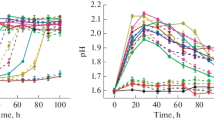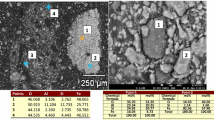Abstract
A pure strain of Paenibacillus polymyxa and mineral-adapted strains are used to bring about surface chemical changes on pyrite and chalcopyrite and, thus, their flotation. Paenibacillus polymyxa was adapted by repeated subculturing in the presence of pyrite and chalcopyrite. The surface chemical changes of bacteria due to adaptation and of minerals after their interaction with bacterial cultures are evaluated by electrokinetic and infrared spectroscopy and are discussed with reference to their flotation responses. Interaction of bacterial cells, bacterial metabolites and whole bacterial cultures affected the Hallimond flotation behavior of the sulfide minerals. The Xanthate flotation results show that pyrite, but not chalcopyrite, is depressed when the tests are carried out after interaction with chalcopyrite-adapted Paenibacillus polymyxa. This investigation demonstrated that the surface chemical properties of bacteria can be manipulated successfully to achieve the desired effects in the flotation process.
Similar content being viewed by others
References
Amaro, A.M., Chamorro, D., Seeger, M., Arredendo, R., Peirano, I., and Jerez, C.A., 1991, “Effect of external pH perturbations on in vivo protein synthesis by acidophilic bacterium Thiobacillus ferrooxidans,” J. Bacteriol, Vol. 173, pp. 910–915.
Aneja, K.R., 1996, Experiments in Microbiology, Plant Pathology, Tissue Culture and Mushroom Cultivation, Wishwa Prakashan, New Delhi, ISBN: 81-73280827, 35 pp.
Ash, C., Priest, F.G., and Collins, M.D., 1993, “Molecular identification of rRNA group of 3 Bacillii using a PCR probe test,” Ant. Van. Leeuwenhoek, Vol. 64, pp. 253–260.
Bellamy, L.J., 1975, The Infrared spectra of complex molecules, Vol. 1, 3rd ed., Chapman & Hall, London.
Bendinger, B., Rijnaarts, H.M., Altendork, K., and Zehnder, A.J.B., 1993, “Physiochemical cell surface and adhesive properties of coryneform bacteria related to the presence and chain length of mycolic acids,” Appl. Environ. Microbiol, Vol. 59, pp. 3973–3977.
Blake, R.C., Shute, E.A., and Howard, G.T., 1994, “Solubilisation of minerals by bacteria: Electrophoretic mobility of Thiobacillus ferrooxidans in the presence of iron, pyrite and sulfur,” Appl. Environ. Microbiol, Vol. 60, pp. 3349–3357.
Deflaun, M.F., Tanger, A.S., McAteer, A.L., Marshall, B., and Levy, S.B., 1990, “Development of an adhesion assay and characterisation of an adhesion-deficient mutant of Pseudomonas fluorescens,” Appl. Environ. Microbiol, Vol. 56, pp. 112–119.
Deo, N., and Natarajan K.A., 1997, “Interaction of Bacillus polymyxa with some oxide minerals with reference to mineral beneficiation and environmental control,” Mineral Engg., Vol. 10, No. 2, pp.1339–1354.
Deo, N., and Natarajan K.A., 1998a, “Biological removal of some flotation collector reagents from aqueous solutions and mineral surfaces,” Minerals Engg., Vol. 11, No. 8, pp. 717–738.
Deo, N., and Natarajan, K.A., 1998b, “Studies on interaction of Paenibacillus polymyxa with iron ore minerals in relation to beneficiation,” Int. J. Miner. Process, Vol. 55, pp. 41–60.
Devasia, P., Natarajan, K.A., Sathyanarayana, D.N., and Ramananda Rao, G., 1993, “Surface chemistry of Thiobacillus ferrooxidans relevant to adhesion on mineral surfaces,” Appl Environ. Microbiol, Vol. 59, pp. 4051–4055.
Dogan, M.Z., Ozbayoglu, G., Hicyilmaz, C., Sarikaya M., and Ozcengiz, G., 1985, “Bacterial leaching versus bacterial conditioning and flotation in desulfurisation of coal,” XVth Int. Miner. Process. Cong., Cannes, pp. 304–313.
Girczys, J., and Laskowski, J., 1972, Transactions AIME, Vol. 81, pp. C118.
Healy, T.W., and Moignard, M.S., 1976, “A review of electrokinetic study of metal sulfides,” Flotation, A.M. Gaudin Memorial Volume-1, M.C. Fuerstenau, ed., American Institute of Mining, Metallurgical and Petroleum Eng., 275 pp.
Irvin, R.T., 1990, “Hydrophobicity of proteins and bacterial fimbriae,” Microbial cell surface hydrophobicity, R.J. Doyle and M. Rosenberg, eds., Am. Soc. Microbiology, Washington D.C., pp. 137–138.
Jerez, C.A., Seeger, M., and Amaro, A.M., 1992, “Phosphate starvation affects the synthesis of outer membrane proteins in Thiobacillus ferrooxidans” FEMS Microbiol Lett., Vol. 98, pp. 29–33.
Lyalikova, N.N., and Lyubavina, L.L., 1986, “On the possibility of using a culture of Thiobacillus ferrooxidans to separate antimony and mercuric sulfides during flotation,” Fundamentals and Biohydrometallurgy, R.W. Lawrence, R.M.R. Branion and H.B. Ebner, eds., Elsevier, New York, pp. 403–406.
Marshal, K.C., 1976. Interfaces in Microbial Ecology, Harvard University Press, Cambridge, Massachusetts, pp. 27–52.
McGlashan, D., Rovig, A., and Podonik, D., 1969, “Assessment of Interfacial reactions of chalcopyrite,” Transactions AIME, Vol. 244, pp. 446.
Mishra, M., and Chen, S., 1995, “The effect of growth medium of Thiobacillus ferrooxidans on pyrite and galena flotation,” Mineral Bioprocessing, D. Holmes and R.W. Smith, eds., Miner. Met. Mater. Society.
Naumann, D., Schultz, C.P., and Helm, D., 1996, “What can infrared spectroscopy tell us about the structure and composition of intact bacterial cells?”, Infrared spectroscopy of Biomolecules, H.H. Mantsch and D. Chapman, eds., Wiley-Liss Inc., ISBN 0471021849, pp. 279–310.
Nikaido, H., and Varra M., 1985, “Molecular basis of bacterial outer membrane permeability,” Microbiol Rev., 49, pp. 1–32.
Rijnaars, H.M., Norde, W., Lyklema, J., and Zehnder, A., 1995, “The isoelectric point of bacteria as an indicator for the presence of cell surface polymers that inhibit adhesion,” Coll. Surf., B., 4, pp. 191–197.
Stanier, Y.R., Ingraham, J.L., Wheelis, M.L., and Painter, P.R., 1993, General Microbiology, 5th ed., Macmillian, London.
Townsley, C.C., Atkins, A.S., and Davis, A.J., 1987, “Suppression of pyrite sulfur during flotation by Thiobacillus ferrooxidans,” Biotech. Bioengg., Vol. 30, pp. 1–8.
Twardowski, J., and Anzenbacher, P., 1994. Raman and IR spectroscopy in biology and biochemistry, Ellis Horwood, London and Polish Scientific Publishers, Warsaw.
Yelloji Rao, M.K., Natarajan, K.A., and Somasundaran, P., 1991, “Effect of bacterial conditioning of sphalerite and galena with Thiobacillus ferrooxidans on their floatability,” Mineral Bioprocessing, R.W. Smith and M. Mishra, eds., Miner. Met. Mater. Soc, pp. 105–120.
Author information
Authors and Affiliations
Rights and permissions
About this article
Cite this article
Sharma, P.K., Rao, K.H. Role of a heterotrophic Paenibacillus polymyxa bacteria in the bioflotation of some sulfide minerals. Mining, Metallurgy & Exploration 16, 35–41 (1999). https://doi.org/10.1007/BF03403232
Received:
Accepted:
Published:
Issue Date:
DOI: https://doi.org/10.1007/BF03403232




